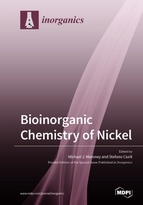Bioinorganic Chemistry of Nickel
A special issue of Inorganics (ISSN 2304-6740). This special issue belongs to the section "Bioinorganic Chemistry".
Deadline for manuscript submissions: closed (31 May 2019) | Viewed by 55811
Special Issue Editors
Interests: bioinorganic chemistry; metal trafficking; metallocenter assembly; X-ray spectroscopy; structure/function relationships in metal coordination chemistry
Interests: bioinorganic chemistry; biochemistry of metal ions; protein NMR spectroscopy; protein crystallography; nickel in biology; metal transport in biological systems; metal coordination chemistry
Special Issue Information
Dear Colleagues,
The chemistry of nickel in biological systems has been intensely investigated since the discovery of the essential role played by this transition metal in the enzyme urease, ca. 1975. Since then, several nickel-dependent enzymes have been discovered and characterized at the molecular level using structural, spectroscopic, and kinetic methods, and insight into reaction mechanisms has been elaborated using synthetic and computational models. The dual role of nickel as both an essential nutrient and as a toxin has prompted efforts to understand the molecular mechanisms of nickel toxicology and to uncover the means by which cells select nickel from among a pool of different and more readily available metal ions, and thus regulate the intracellular chemistry of nickel. This latter effort highlights the importance of proteins involved in the extra- and intra-cellular sensing of nickel, the roles of nickel-selective proteins for import and export, and nickel-responsive transcription factors, all of which are important for regulating nickel homeostasis. In this Special Issue, we wish to cover the most recent advances in all these aspects of nickel biochemistry by hosting a mix of original research articles and short critical reviews.
Prof. Dr. Michael J. Maroney
Prof. Dr. Stefano Ciurli
Guest Editors
Manuscript Submission Information
Manuscripts should be submitted online at www.mdpi.com by registering and logging in to this website. Once you are registered, click here to go to the submission form. Manuscripts can be submitted until the deadline. All submissions that pass pre-check are peer-reviewed. Accepted papers will be published continuously in the journal (as soon as accepted) and will be listed together on the special issue website. Research articles, review articles as well as short communications are invited. For planned papers, a title and short abstract (about 100 words) can be sent to the Editorial Office for announcement on this website.
Submitted manuscripts should not have been published previously, nor be under consideration for publication elsewhere (except conference proceedings papers). All manuscripts are thoroughly refereed through a single-blind peer-review process. A guide for authors and other relevant information for submission of manuscripts is available on the Instructions for Authors page. Inorganics is an international peer-reviewed open access monthly journal published by MDPI.
Please visit the Instructions for Authors page before submitting a manuscript. The Article Processing Charge (APC) for publication in this open access journal is 2700 CHF (Swiss Francs). Submitted papers should be well formatted and use good English. Authors may use MDPI's English editing service prior to publication or during author revisions.
Keywords
- nickel biochemistry
- nickel homeostasis
- nickel transport
- nickel enzymes
- nickel model chemistry







